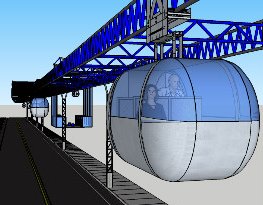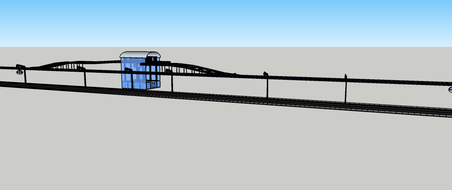CityTram
A new vision in urban commuting
A better way
to get from here to there
(faster and cheaper, reliably and safely)
Concept What is this new vision? How does it differ from mass transit ?
PERSONAL AUTOMATED TAXI
- Personal
CityTram is a vision for publically operated personal (not mass) transit. Similar to a rental car, the commuter has temporary exclusive use of his or her own personal vehicle - but only for a single trip. The vehicle size reflects that “personal” use, rather than the larger size of “shared use” vehicles more common to mass transit. The cabin size of the Citytram car is roughly comparable to the cabin size of a compact car. It is intended to carry 1, 2, or possibly 3 adults. 4 people might make use of the vehicle if several of them are children. The seats are child-seat compatible. There is enough space for light cargo, such as groceries, brief cases, or personal luggage. Bicycles are accommodated (but only for travelling groups of 1 or 2). Total load capacity is set at 1100 lbs, including the vehicle itself which weights approximately 350 lbs, and 750 lbs of passengers and cargo. These specifications should be sufficient to cover the needs of the vast majority of commuting trips – to and from work, school, shopping, entertainment, and long distance transit centers (airports, train stations, etc).
- Automated
The CityTram vehicles are completely self-driving. In fact the cars themselves are passive. They are moved along the rails by a pusher system, much like goods are moved along an assembly line conveyor in an automated factory. A centralized computer controls the whole system and "drives" the car. This not only eliminates the labor costs associated with transit drivers, but it also assures access to all. No driver’s license is needed, so children, the elderly, the disabled, foreign visitors, and those at risk for a DUI can commute just as easily as anyone else. Because the system is centrally controlled and computer controlled, rather than controlled by a distributed group of human operators possessing varying levels of skill, it can be much safer. Also because the system is controlled by computer rather than humans, reaction times are faster. This allows the system to be more efficient and entry controlled, and so congestion is avoided even in high demand situations.
This central computer control is much more akin to today’s industrial automation systems that keep assembly lines flowing in a factory, rather than something like Google’s autonomous vehicle that attempt to replace the distributed human control. Mass deployment of self-driving cars is still 20 years in the future. CityTram’s separated grade creates a closed environment that is protected from the types of random intrusions and interactions that complicate autonomous control. Therefore the sophistication of sensory input and processing intelligence is far more modest for CityTram’s type of industrial automation. Just think of our city as our factory, and the people moving through it as the products moving between work-stations in the factory, and you can see that we already know how to do this safely and reliably, and inexpensively. People mover systems at airports around the world have been doing this task safely for years. CityTram’s proprietary constant motion control makes extending this type of control to 2D networks relatively simple.
- Taxi
CityTram is a taxi system. Vehicles pick up commuters where they are (or very close), and drop them off where they are going (or very close). There is no notion of pre-defined travel routes, like for buses or trains. The vehicles make no intervening stops along the way. Access to a taxi is gained at a local taxi stand (called a station), where empty taxis are parked and waiting. Taxi stands are no more than 1/2 mile apart, so the longest walk for access is 1/4 mile. Taxi stands are "off-line" or on a "siding", meaning that occupied taxis drive straight past taxi stands along the way, without stopping. So CityTram travel is very similar to car travel - a short walk to the parked vehicle, a non-stop drive by a direct route to a parking area near the destination, and then a short walk to the destination. But the drive will be truly non-stop since there are no traffic lights; and no time will be wasted searching for an available parking space at the destination. As a result, in many instances CityTram can actually get the rider there faster than driving a personal car.


